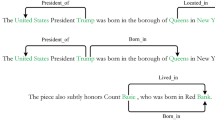Abstract
Relations extraction is a widely researched topic in nature language processing. However, most of the work in the literature concentrate on the methods that are dealing with single relation between two named entities. In the task of multiple relations extraction, traditional statistic-based methods have difficulties in selecting features and improving the performance of extraction model. In this paper, we presented formal definitions of multiple entities and multiple relations and put forward three labeling methods which were used to label entity categories, relation categories and relation conditions. We also proposed a novel relation extraction model which is based on dynamic long short-term memory network. To train our model, entity feature, entity position feature and part of speech feature are used together. These features are used to describe complex relations and improve the performance of relation extraction model. In the experiments, we classified the corpus into three sets which are composed of 0–20 words, 20–35 words and 35+ words sentences. On conll04.corp, the final precision, recall rate and F-measure reached 72.9, 70.8 and 67.9% respectively.








Similar content being viewed by others
Notes
References
Che WX, Liu T, Li S (2005) Automatic entity relation extraction. J Chin Inf Process 19(2):1–6
Chen Y, Zheng DQ, Zhao TJ (2012) Chinese relation extraction based on deep belief nets. J Softw 23(10):2572–2585
Duan LG, Xu Q, Li AP, Cui MJ (2017) Research on effect of entities semantic information on Chinese entity relation extraction. Appl Res Comput 34(1):141–146
Gan LX, Wan CX, Liu DX, Zhong Q, Jiang TJ (2016) Chinese named entity relation extraction based on syntactic and semantic features. J Comput Res Dev 53(2):284–302
Hochreiter S, Schmidhuber J (1997) Long short-term memory. Neural Comput 9(8):1735–1780
Hoffmann R, Zhang CL, Ling X, Zettlemoyer L, Weld DS (2011) Knowledge-based weak supervision for information extraction of overlapping relations. In: Proceedings of the 49th annual meeting of the association for computational linguistics: human language technologies, vol 1, pp 541–550
Hu XC (2015) Semantic relation classification based on LSTM networks. Dissertation for the Master Degree in Engineering in Harbin Institute of Technology
Liu XY (2015) A semi-supervised method based on tree kernel for relationship extraction. J Shandong Univ 45(2):22–26
Liu L, Li BC, Zhang XF (2008) Named entity relation extraction based on SVM training by positive and negative cases. Comput Appl 28(6):1444–1446
Miller S, Fox H, Ramshaw L, Weischedel R (2000) A novel use of statistical parsing to extract information from text. In: Proceedings of the 1st North American Chapter of the Association for Computational Linguistics conference. Association for Computational Linguistics, pp 226–233
Park Y, Lee M, Kim MH, Lee JW (2016) Analysis of semantic relations between multimodal medical images based on coronary anatomy for acute myocardial infarction. J Inf Process Syst 12(1):129–148
Qian LH, Zhou GD, Kong F, Zhu QM, Qian PD (2008). Exploiting constituent dependencies for tree kernel-based semantic relation extraction. In: COLING’2008 Manchester, pp 697–704
Qin B, Liu AA, Liu T (2015) Unsupervised Chinese open entity relation extraction. J Comput Res Dev 52(5):1029–1035
Rong BH, Fu K, Huang Y, Wang Y (2017) Relation extraction based on multi-channel convolutional neural network. Appl Res Comput 34(3):689–692
Valêncio CR, Oyama FT, Neto PS, Colombini AC, Cansian AM, RCG Souza, Corrêa PLP (2012) MR-Radix: a multi-relational data mining algorithm. Hum Centric Comput Inf Sci 2(1):4
Viswanathan V, Krishnamurthi I (2012) Finding relevant semantic association paths through user-specific intermediate entities. Hum Centric Comput Inf Sci 2(1):1–11
Zeng DJ, Liu K, Lai SW, Zhou GY, Zhao J (2014) Relation classification via convolutional deep neural network. In: Proceedings of COLING 2014, the 25th international conference on computational linguistics. Technical Papers, pp 2335–2344
Zhou GD, Su J, Zhang J, Zhang M (2005) Exploring various knowledge in relation extraction. In: Proceedings of the 43rd annual meeting on Association for Computational Linguistics, Stroudsburg, PA, USA: Association for Computational Linguistics, pp 427–434
Zhuang CL, Qian LH, Zhou GD (2009) Research on tree kernel-based entity semantic relation extraction. J Chin Inf Process 23(1):3–9
Acknowledgements
This work was supported by Shanghai Maritime University research fund project (20130469), and by Shanghai Science & Technology Innovation Plan Fund (14511107400), and by State Oceanic Administration China research fund project (201305026). It was also supported by the open research fund of Key Lab of Broadband Wireless Communication and Sensor Network Technology (Nanjing University of Posts and Telecommunications), Ministry of Education.
Author information
Authors and Affiliations
Corresponding author
Ethics declarations
Conflict of interest
The authors declare that they have no conflict of interest.
Ethical approval
This article does not contain any studies with human participants performed by any of the authors.
Additional information
Communicated by J. Park.
Rights and permissions
About this article
Cite this article
Liu, J., Ren, H., Wu, M. et al. Multiple relations extraction among multiple entities in unstructured text. Soft Comput 22, 4295–4305 (2018). https://doi.org/10.1007/s00500-017-2852-8
Published:
Issue Date:
DOI: https://doi.org/10.1007/s00500-017-2852-8




